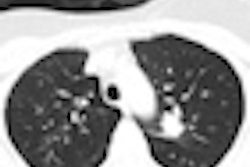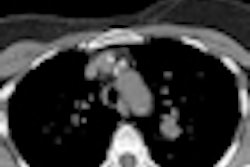Three-fourths of lung cancers detected through CT screening are aggressive, according to the results of a study in the Annals of Internal Medicine that boosts the value of CT screening while tamping down fears of overdiagnosis.
In a retrospective analysis of 175 individuals at high risk of developing lung cancer, researchers from the European Institute of Oncology in Milan found that 75% of CT-detected incident lung cancers had volume-doubling times (VDTs) of 400 days or less.
The results suggest that the phenomenon of overdiagnosis from screening -- that is, detecting cancers that would never become dangerous to patients -- is less of a problem than some have feared. For the remaining 25% of cancers that were likely to have been overdiagnosed, less-invasive treatment options that reduce the risks of morbidity may be helpful, they added.
"Our VDT analysis of nonprevalent lung cancer diagnosed in the ... screening study suggests that at least approximately 75% of detected cases were aggressive, downsizing the problem of overdiagnosis," wrote Dr. Giulia Veronesi, Patrick Maisonneuve, Dr. Massimo Bellomi, PhD, and colleagues (Ann Intern Med, December 4, 2012, Vol. 157:11, pp. 776-784).
The overdiagnosis dilemma
Overdiagnosis is a potential disadvantage of CT lung cancer screening that can increase costs and lead to overtreatment and potentially unnecessary morbidity, Veronesi and colleagues noted. Thus, the higher the percentage of indolent or slow-growing cancers in the screening population, the greater potential harm and the lower the potential benefit of screening. The prevalence of slow-growing cancers in the screening population is not well understood.
However, the literature suggests that whatever the level of overdiagnosis, it doesn't outweigh the benefits of screening; its negative effects can be counterbalanced by the benefit of reduced mortality among screened individuals, the authors wrote.
"The large, randomized [National Lung Screening Trial (NLST)] found that lung cancer mortality was 20% ... even though more cases of lung cancer were diagnosed in the screened group," they wrote. "All-cause mortality also was 7% lower ... in the [low-dose CT (LDCT) group] than the control group."
Aiming to improve their understanding of the scope of overdiagnosis among high-risk individuals, the researchers assessed the growth rate (expressed in VDT) of incident lung cancer detected by low-dose CT screening over five consecutive years. VDT was used to identify slow-growing cancers, and track these patients' clinical outcomes versus those with faster-growing lesions.
The researchers recruited volunteers consisting of heavy smokers or former smokers (20 or more pack-years of smoking history) from the single-center Continuous Observation of Smoking Subjects (COSMOS) study, excluding participants with a history of cancer in the five previous years. The participants agreed to be screened every five years with CT, performed on an 8- or 16-detector-row scanner (HiSpeed Advantage, GE Healthcare). Volume and thus VDT were calculated using a commercially available software application (Lesion Management Solutions-Lung, Median Technologies).
Participants with nodules 5 mm or smaller were rescanned a year later, while those with nodules 5 to 8 mm in diameter were rescanned three months later. Most participants with noncalcified nodules larger than 8 mm underwent PET/CT. Surgical biopsy and other interventions were performed for individuals with growing or PET/CT-positive nodules. Lesion volume-doubling times were classified as fast-growing (VDT < 400 days), slow-growing (VDT from 400-599 days), or indolent (VDT ≥ 600 days).
The study team diagnosed 175 lung cancer cases: 55 at baseline screening and 120 diagnosed subsequently. Of the latter group, 19 cases (15.8%) were new -- that is, not seen on previous scans -- and fast-growing, with a median VDT of 52 days. The remaining 101 cases (84.2%) were progressive, including 70 (58.3%) that were fast-growing and 31 (25.8%) that were slow-growing (15.0%) or indolent (10.8%).
The median VDT was 223 days among the fast-growing cancers and 545 days among the slow-growing or indolent cancers, Veronesi and her team reported. The median VDT for adenocarcinomas was 303 days, compared with 77 days for squamous cell carcinomas and 70 days for small cell cancers. In all, 62% of the baseline cases, 45% of the new cancers, 66% of the fast-growing progressive cancers, and 84% of slow-growing or indolent cancers were stage I.
Analysis of the results showed a statistically significant correlation between VDT and risk level assessed by the COSMOS risk-assessment method. The median VDT of lung cancer was significantly shorter in the high-risk lung cancer group (210 days) than in the low-risk group (341 days, p < 0.021). There were a total of 21 deaths, including 15 from the originally diagnosed lung cancer. Seventeen deaths occurred among those with fast-growing cancers, with four deaths occurring in the slow-growing or indolent patient group.
A 2008 article by Dr. Peter Bach proposed that screening primarily detected indolent early cancers and aggressive advanced cancers (Lancet Oncology, July 2008, Vol. 9:7, pp. 693-697). Because of this mix, screening would do little to reduce lung cancer mortality. However, Veronesi and colleagues countered that assertion, finding that VDT was distributed continuously, from very slow-growing (VDT of 600 days or more) to fast-growing, "with no evidence of the biphasic distribution that Bach suggested."
"The main finding of our study is that VDT seems to be a plausible indicator of cancer aggressivity in cases of incident cancer," they wrote.
Lung cancer mortality increased with each category of faster VDT, and the prognosis was highly favorable for cancer cases with VDT of 200 days or more, they wrote.
They also found a direct correlation between VDT and lung cancer risk as estimated by the COSMOS risk model. This is an indication that slow-growing cancer is more common in low-risk people who also tend to be relatively young and less exposed to tobacco smoke.
"This finding suggests that increasing the screening interval for persons with a low cancer risk score would be useful and safe," they wrote. "We acknowledge, however, that nodules under regular surveillance that are stable for years may rarely undergo sudden explosive growth."
Thus, volume-doubling times of 400 days or more are suggestive of indolent cancer and overdiagnosis, although the data support that statement even for VDTs of 200 or more, they wrote.
Another important finding was that early diagnosis and early treatment, even of fast-growing cancers, resulted in good long-term survival in the study cohort.
"Having identified potentially overdiagnosed lung cancer as slow-growing or indolent lesions, the problem of managing them remains," Veronesi and colleagues wrote. "Some authors suggest the conservative wait-and-see policy. However, the growth rate of some cases of indolent cancer can increase markedly from one scan to the next so that they become life-threatening."
The COSMOS study treated all suspicious nodules with standard resection; however, less-aggressive interventions may be appropriate for slow-growing or indolent cancers considering the low risk for nodal involvement with PET-negative and subcentimeter nodules, the authors wrote. In this vein, several trials are under way to evaluate the long-term outcomes of wedge resection or segmentectomy and lymph node dissection for stage IA cancers 2 cm and larger. The authors also encourage the use of video-assisted thoracoscopic surgery and robot-assisted surgery for managing small lung cancers because these techniques reduce surgical trauma and postoperative pain.
Future models could boost the cost-effectiveness of CT screening and reduce the risk for overdiagnosis, while new chemotherapy agents that work against lung adenocarcinomas may eventually enable treatment without surgery for some patients.
The data from this study suggest that "at least approximately 75% of detected cases were aggressive, downsizing the problem of overdiagnosis," they wrote. "Among the 25% of slow-growing or indolent cases, many are likely to have been overdiagnosed. To limit overtreatment in such cases, minimally invasive limited resection and nonsurgical treatments should be investigated prospectively."



















